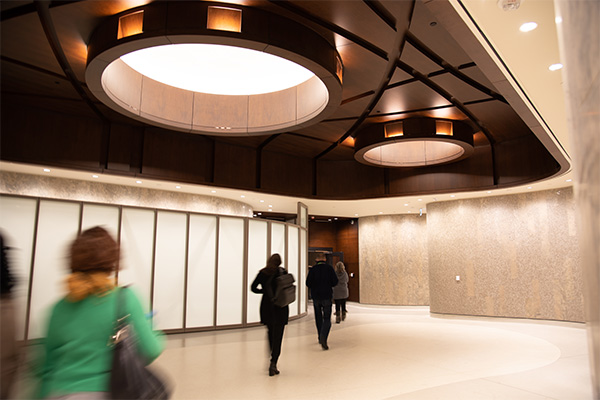Highlights from the Hill
The publication of House proceedings and parliamentary information is a key component of our democratic system that makes Parliament accessible to all Canadians. It is the House of Commons’ responsibility to ensure that the Canadian public is able to stay informed and get involved in the parliamentary process and in Members’ work.
Welcoming visitors back to Parliament
In March 2020, when the COVID‑19 outbreak was declared a global pandemic, the Board of Internal Economy (the Board) decided to restrict visitor access to the precinct, and suspend public tours, committee travel, and in-person parliamentary functions and events as a precautionary measure.
On April 25, 2022, after being closed for just over two years, the Chamber’s gallery and committees reopened to the public, allowing people to once again witness the work of Members and committees in person. General public access and guided tours resumed shortly after, on May 20, 2022.
When it reopened to the public, the House of Commons maintained the public health protocols it had put in place in response to the pandemic. The Board decided to relax its health measures following adjustments to the COVID‑19 restrictions imposed by public health authorities, and the obligation to wear a mask in the precinct was lifted on June 23, 2022.

Discover (or rediscover) the House of Commons
A visit to Parliament Hill is the best way to uncover the workings, as well as the history, functions, art and architecture of the House of Commons. In addition to in-person tours of this remarkable place, the House Administration launched the following resources in 2022–2023 for those who cannot make it on site.
- The renewed History, Art and Architecture section of the House of Commons website showcases the architectural spaces, works of art and other objects that tell their own fascinating history of Parliament.
- ProceduralInfo is a collection of tools and resources that make it easier to understand the work of Members as well as the procedural rules and practices of the House of Commons and its committees.
Everyone’s House
The House of Commons is central to our democracy and dedicated to representing our diverse country. As a place of work and a public space, it strives to be an inclusive and accessible environment not just for Members, their staff, and House Administration employees, but for all Canadians and visitors taking part in parliamentary business.
Accessibility: identifying, removing and preventing barriers
Inclusion has always been an important consideration in the House of Commons’ operations. In the last several months, the House has been working to better understand accessibility challenges, with the goal of drafting an accessibility plan and establishing a barrier-free environment.
What is a barrier?
A barrier is anything that hinders the full and equal participation in society of persons with an impairment, including a physical, mental, intellectual, cognitive, learning, communication or sensory impairment or a functional limitation. This includes anything physical, architectural, technological or attitudinal.
Source: Accessible Canada Act
The Accessible Canada Act came into force on July 11, 2019, with the goal of creating a Canada without barriers by 2040, particularly for persons with disabilities. In January 2022, the House of Commons created an accessibility working group comprised of management, employees and subject-matter experts from all areas of the organization. The working group developed the Administration’s first accessibility plan, which was officially published on December 1, 2022. The Accessibility Plan 2023–2025 was informed by consultations with persons living with a wide range of disabilities, Members of Parliament and their staff, as well as employees of the House Administration, and developed in accordance with the Accessible Canada Act.
An inclusive, diverse and engaged workforce
The House of Commons is dedicated to fostering a workplace that embraces all cultures, social identities, abilities and perspectives. Over the past few years, the new core value of inclusion was incorporated in the strategic plan, and tools and programs were developed to support a workplace reflective of Canada’s evolving population.
The House of Commons’ Diversity Council, made up of employees from all areas and levels of the Administration, is committed to building employee awareness and employee engagement in activities that will help strengthen the value of inclusion and the House’s strategic and operational priorities. This year, the Diversity Council, in collaboration with the Workplace Inclusion, Diversity and Equity team, designed an extensive work plan focused on staff recognition and training, and on forum and event planning—all to break down barriers and help employees create a truly inclusive and safe workplace.

The House Administration’s Policy on Workplace Inclusion, the Anti-Racism Subcommittee, the Women’s Leadership Network, and the Respectful Workplace Team are all examples of initiatives aiming to build awareness and identify opportunities for improvement at the House.
On August 28, 2022, the House Administration invited its employees to march alongside their colleagues and parliamentary partners in the Capital Pride Parade. The annual parade is an opportunity for 2SLGBTQI+ communities in the National Capital Region to celebrate, advocate for, and educate people about their diversity, and for allies to show their support.
House Administration employees are known for their generosity and commitment to giving back to the community. Once again this year, the House Administration was an active partner in the federal Workplace Charitable Campaign initiative, which builds awareness and raises funds to help individuals and organizations in need. Dozens of employees volunteered to organize fundraising activities, and together they raised $118,421 for registered Canadian charities.

Supporting Members’ work
In 2022–2023, the House Administration continued its efforts to restore and modernize its physical and digital workspace to support Members’ evolving needs. This was especially important as the severity of the pandemic lessened and the House saw a return to more normal parliamentary operations. Always looking to simplify access to services to facilitate Members’ work, the Administration launched a new system for planning meetings and events and arranging access for visitors on the Hill. Other accomplishments include the creation of a security records management system and a new case management and reporting framework for occupational health and safety.
The new Client Care Team was introduced on April 1, 2022, to streamline access to the House Administration’s services and offer a simplified service experience. This new centralized team, brings together client care experts from across the organization, removing barriers and facilitating the work of Members and their employees.

Ensuring that employees are heard
In developing the House’s first accessibility plan, consultations were held with people living with various disabilities to better understand the barriers they face. The feedback collected through surveys and workshops was instrumental in the plan’s preparation.
Giving employees a voice and creating a feedback culture are an effective way for the organization to hear ideas and concerns on a wide range of topics. In 2022–2023, in addition to providing regular updates on COVID‑19 pandemic measures to Members and employees, the House Administration conducted its fourth COVID‑19 pulse survey to better understand how the workforce was adapting to the situation and to guide planning for the future of the workplace.
To inform its efforts in preparing a new strategic plan and help shape the vision, mission, values and priorities for the next three years, the House Administration organized a series of consultations with employees from across the organization. The new strategic plan came into effect in April 2023.